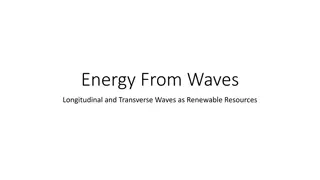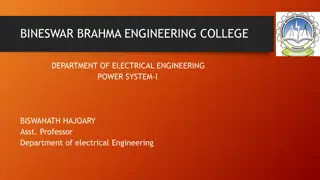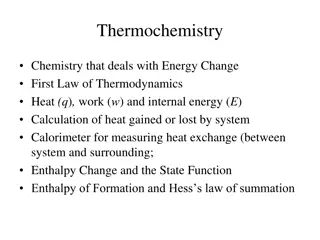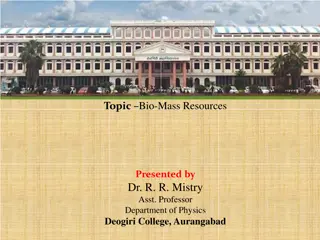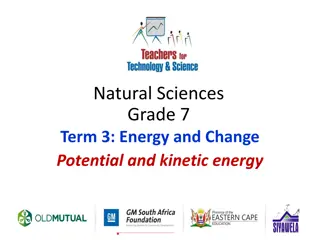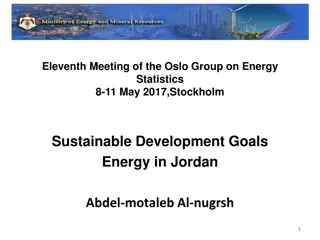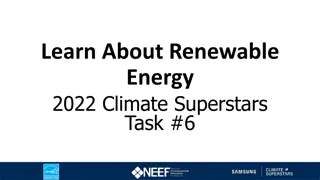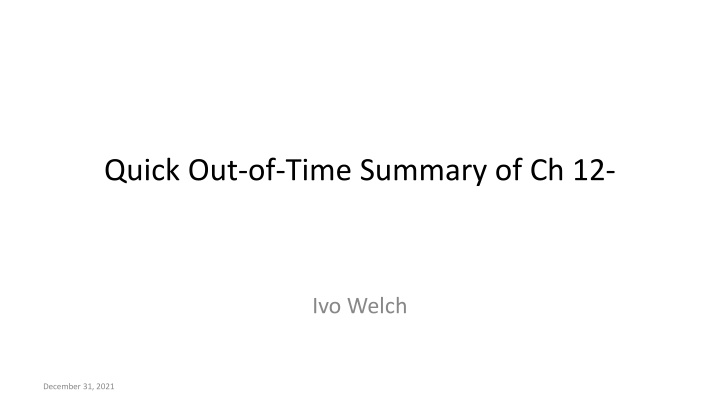
Energy Solutions and Challenges in Our Generation
The book delves into the complexities of energy production and storage, highlighting the need to address challenges such as the high cost of green hydrogen and regulatory hurdles in the nuclear power sector. It contemplates future energy solutions, including advancements in battery technology and potential for small-scale reactors. With insights on lithium chemistries and the evolving landscape of energy generation, the discussion underscores the importance of innovative approaches for sustainable energy practices.
Download Presentation

Please find below an Image/Link to download the presentation.
The content on the website is provided AS IS for your information and personal use only. It may not be sold, licensed, or shared on other websites without obtaining consent from the author. If you encounter any issues during the download, it is possible that the publisher has removed the file from their server.
You are allowed to download the files provided on this website for personal or commercial use, subject to the condition that they are used lawfully. All files are the property of their respective owners.
The content on the website is provided AS IS for your information and personal use only. It may not be sold, licensed, or shared on other websites without obtaining consent from the author.
E N D
Presentation Transcript
Quick Out-of-Time Summary of Ch 12- Ivo Welch December 31, 2021
Etiquette Do not leave your computer or notebook open when we have speakers. Please pay attention, and ask good questions.
READ You must read the book for the final and information.
More Energy and Power Book contains explanations about Watts and Watt-hours, power and energy. We need to wrangle about 150 PWh of energy within one generation.
Green Hydrogen Hopeless, because it is too expensive. Green = 10x NatGas cost today; maybe 2x in 40 years? Unknown Use Cases. Given whatever E cost: Think batteries for overnight storage (whatever price of E) Think E salt heat , instead of E hydrogen heat Long-Distance Transport Maybe if competitive
Nuclear Power Painful regulation. Some regulation is absolutely needed, though much NRC regulations has remained just stupid. (Even dumber in Germany now.) Did NRC regulation kill nuclear power? probably not same problem have appeared in every country not just NRC
Hopeless, because todays reactors are economically uncompetitive against NatGas and clean energy. Future (small?) reactors could become competitive maybe Humanity could sure use more energy solutions. Fusion plants are economically no different. If someone solves the clean-energy storage problem, nuclear plants could be obsolete before they even open. Many other problems, too, but probably solvable Absolutely dead-serious and need consideration, though.
Batteries Not good enough for energy density and for cost today for complete takeover. grid means some places need just 4h; Li already great! not cost-effective for 12 hours (NatGas). Improving every year. They will be good enough. optimal choice: go slow!
Lithium Chemistries Modest toxicity, clean mining, water reactive. Anode and cathode make huge difference dendrites (tendrils); capacity. component costs Batteries are getting much better every year, soon 3,000 cycles; could perhaps become 100,000 cycles! Plenty of lithium (e.g., Salton Sea) price: $1,200/KWh in 2010; $150/KWh in 2020! $75/KWh in 2035?
Other Chemistries Many different possible chemistries Watch out for flow batteries, etc. Solve the storage cost problem and fossil fuels are done. Clean energy generation is already much cheaper.
Clean Energy (=Usually Electricity) Lots of FUD, often surreptitious. Recycling of turbines is not a problem. Large area needed is not a problem. size of Massachusetts? compare to agriculture (and not competing!) should be placed close to use and grid
Huge energy transition takes lots of time. Optimal deployment is slow while costs are coming down. There will be many short-term delays and hickups
Dispatchable (Storage) All heat plants that don t operate 24/7 are very cost inefficient. Even otherwise cheap NatGas plants.
Grid/Allocation problems Tremendous Time and Location matters uncertainty (supply and demand); short-term (which plants to switch on); long-term (which plants to build where); how to move E around (transmission). Balancing Act: Markets and Regulation historically encumbered in the USA
World Even more heterogeneous than USA. It is not enough to decarbonize US! In fact, it s almost useless.
USA U.S. NatGas Coal Wind Power 45% 20% 10% Energy 40% 20% 9%
U.S. Nuclear Hydro Solar Power 10% 10% 5% Energy 20% 7% 2%
Power/Energy Mix Comparison Nuke GeoT Coal Gas USA 20% 1% 19% 40% World 10% 0% 37% 24%
Hydro Wind Solar Other USA 7% 9% 2% 2% World 16% 5% 3% 5%
Utility-Scale High Fixed Costs Almost all cases: First-order is fixed cost built or not built 30-year replacement or new needs Rest (variable cost) is often much lower. Amazingly, solar PV fixed cost is now getting so cheap that NatGas plants are installing it to save on NatGas!
New Plants: USA / OECD / China+India+ Within the OECD: For many years now, really only new Wind and Solar plants have made sense; will probably continue; explain below why. Beyond the OECD: Lots of Coal. usually near coal mine and near pop centers already or soon economically obsolete
Levelized Cost Of Electricity (LCOE) Tries to take all costs into account. Projected over lifetime of plant: disagreement over lifetime different LCOEs. If you get it wrong, you may lose a lot of money. Following are ballpark inflation-adjusted figures, differ by location, regulation, etc.
Ballpark LCOEs Per Mwh Type Today est 2050 Nuclear $70 $60 Gas, Always On $40 $45+ Coal $75 $65+
Probably have triple the variable costs in 2022, but LCOE is about planning for 30-50 years. Price probably more likely more like 2020 than 2022.
Type Today est 2050 Nuclear $70 $60 Gas, Always On $40 $45+ Coal $75 $65+ Solar Panels, Roof $100 $30 Solar Panels, Utility $35 $15 Wind, onshore $35 $20 Geothermal $35
Type Today est 2050 Solar Panels, Utility $35 $15 Wind, onshore $35 $20 Hydro $55 Gas, Dispatch $200
Clean Energy In sum: Problem is No Longer Cheap Generation! Problem Now is Cheap Energy Storage! Solve it, and wind/solar will take over.
Energy Storage / Batteries Think $200/MWh it costs $10 to buy lunch and $100 to eat it in 20 minutes! Main Li Problem: wears out after 1,000+ cycles. see above. If 10,000+ cycles at same price, good-bye fossil fuels for electricity and short transport. heat is different. think half-price on E. oversea transport is different.
Energy Provision 2015, Twh Coal NatGas Nuke Hydro USA 1,410 1,317 797 249 China 3,860 148 161 1,103 World 9,621 5,585 2,440 3,843
Wind Solar (Oth) Total USA 191 39 (2.2%) 4,092 China 186 45 (1.1%) 5,562 World 828 263 (2.6%) 23,171
Energy Forecast 2050, Twh Coal NatGas Nuke Hydro USA 593 1,953 594 294 China 3,556 803 1,002 1,448 World 8,115 7,306 3,025 5,548
Wind Solar (Oth) Total USA 790 1,071 (3.0%) 5,458 China 1,001 3,379 (0.4%) 11,230 World 6,833 10,152 (2.3%) 41,953
OTHERS NOT DISCUSSED Emissions not primarily a US but global problem Industrial, Steel, Cement Heat and Inputs Agriculture: Very tough. Methane super-emitters (plus many small issues) Sequestration (Timber! Algae, etc.) Geoengineering 1/10,000 the cost; but also problems Lots of good changes, many more modest








